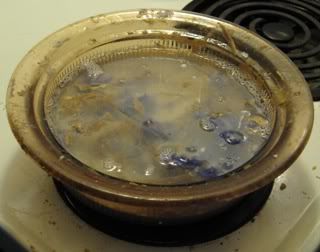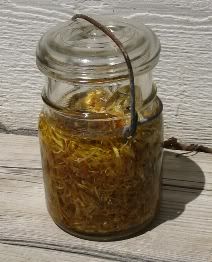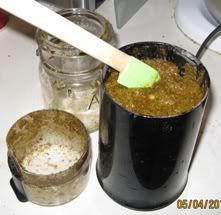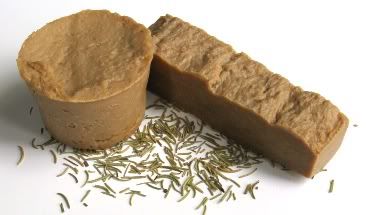
Friday, July 9, 2010
Greg saw his first movie in the theater last night!

Tuesday, July 6, 2010
How to Make Your Own Liquid Laundry Soap

Ingredients:
about 5 ounces of soap
1/4 cup Dawn dish-washing detergent
1 cup borax
1 cup washing soda
hot water
fragrance or essential oil of your choice, optional
Equipment:
2 quart covered saucepan
old liquid laundry detergent bottle
2 funnels
Directions:
1) You will need about 5 ounces of soap pieces. I leave this pan sitting out on the stove top and collect little pieces of soap until I have about 5 ounces. You could also grate up a larger piece of soap or a whole bar using a cheese grater. If I plan to use this laundry soap on whites, I make sure I'm using white or very lightly colored pieces of soap. I don't want to dye my husband's white dress shirts lavender with my laundry soap.

2) Completely cover the soap pieces with water. More water makes this process go faster but too much water and heat can make your soap bubble up into a foamy mixture.

3) Cover the pan and heat on low for 1-2 hours until all the soap pieces are completely dissolved. I usually check on it every 15 min. or so just to make sure it hasn't bubbled over.

4) When the soap is dissolved, pour the hot mixture into the laundry detergent bottle. I find a funnel very helpful.

5) Add 1/4 cup Dawn dish-washing liquid to the soap in the bottle. Normally I would use Original Dawn, but all I had on hand at the time was Ultra Dawn. I add the Dawn because my handmade soap contains moisturizing oils for my skin. My clothes do not need moisturizing so the Dawn helps to trap those extra oils.
6) I use a different funnel (that I made out of a piece of paper) for the dry ingredients. Pour 1 cup of borax and 1 cup of washing soda into the laundry detergent bottle.

7) Fill the bottle up with hot water from the tap. Using hot water is important to help the borax dissolve. Put the lid on and give it a good shake after filling to help in cooperate all ingredients. If I were going to add a fragrance or essential oil, I would do it here at the end. I think 1/2 ounce would be a good starting point to experiment with scent amounts.
8) I use 1/4-1/2 cup of this soap in my wash loads. I do give the bottle a little shake before every use just in case there are some undissolved ingredients.
Tuesday, May 4, 2010
Infusing Herbs into Oils
1) I obtained some dried calendula and chamomile from a local store, The Spice Merchant. I'm going to use about 0.75 oz of each herb to do this infusion.

2) I put the herbs into a pint-sized glass canning jar.
3) I added about 5 oz of rice bran oil and 5 oz of olive oil to the herbs in the jar. Andee suggested I use a colorless oil, like colorless jojoba, so I could see the oil turn yellow. Unfortunately I didn't have any on hand and I was too excited about trying this to wait for the oil that I ordered to come in the mail.

4) I put the jar (with the lid) in a sunny spot on the back deck. When I checked it in the afternoon, I moved it because it was in the shade. The jar was warm but not so hot that I couldn't hold it.

5) I read that I should leave the jar in the sun for 2 days. When I woke up the next day it was raining. I decided to use another method. This time I put the jar in a few inches of water in my 'crafter's saucepan' and heated it on low heat. I checked it a few times to make sure the jar was warm but not too warm. I read that the temperature of the oil should not exceed 120 degrees F. I did this for about 3 hours. Then I turned off the heat and let the whole thing sit for about 3 hours.

6) When the oil returned to room temperature, I strained it. I put a piece of cheese cloth folded so it was 4 layers thick over the mouth of the jar and poured the oil into a bowl. A few tiny specks of herbs went through the cheese cloth but the oil looked pretty smooth. Another http://forum.thesage.com/ member suggested that I use a panty hose in the future to completely remove the herbs.

7) Finished product:

I poured this into a dark tinted plastic bottle for storage. I can tell that something from the herbs remained in the oil because the oil now has the lovely aroma of calendula and chamomile.
8) When I was done with the oil I didn't want to throw out these fragrant herbs still in the jar. I scrapped them into my coffee bean grinder and pureed them.

I mixed the puree with 1/4 cup kosher salt and 1 tablespoon Jojoba oil to create a salt scrub. It feels wonderful on my hands and elbows.

Andee alternatively suggested that the pureed herbs could be added at trace when making calendula soap. I bet that's a wonderful bar of soap!
Sunday, April 18, 2010
Rules, Rules, Rules...
I think one of the greatest Biblical examples of rule-users is Saul. In 1 Samuel 15, God commands Saul to completely destroy the Amalekites and their possessions. Does Saul do it? NO! "7 Then Saul attacked the Amalekites all the way from Havilah to Shur, to the east of Egypt. 8 He took Agag king of the Amalekites alive, and all his people he totally destroyed with the sword. 9 But Saul and the army spared Agag and the best of the sheep and cattle, the fat calves and lambs—everything that was good. These they were unwilling to destroy completely, but everything that was despised and weak they totally destroyed."
Of course the Lord's prophet Samuel finds out that Saul has disobeyed God's directions. When Samuel confronts Saul, he has this answer:
20 "But I did obey the LORD," Saul said. "I went on the mission the LORD assigned me. I completely destroyed the Amalekites and brought back Agag their king. 21 The soldiers took sheep and cattle from the plunder, the best of what was devoted to God, in order to sacrifice them to the LORD your God at Gilgal."
22 But Samuel replied:
"Does the LORD delight in burnt offerings and sacrifices
as much as in obeying the voice of the LORD ?
To obey is better than sacrifice,
and to heed is better than the fat of rams."
Did you see Saul's thinking? I can do whatever I want if I say that I'm sorry after and make a sacrifice to God. What a rule! I have complete control over my life. Please note Samuel's reply, of course God forgives us when we confess our sins, but He's more pleased when we obey Him.
Please don't get me wrong. I'm not talking about when you sin and authentically repent before the Lord. 1 John 1:9 tells us "If we confess our sins, he is faithful and just and will forgive us our sins and purify us from all unrighteousness." We can't fool God. He knows when we are truly sorry for what we did and when we are just sorry that we got caught. His words tells us that in Hebrews 4:12 "For the word of God is living and active. Sharper than any double-edged sword, it penetrates even to dividing soul and spirit, joints and marrow; it judges the thoughts and attitudes of the heart." We can't apply the rule of sinning followed by a sacrifice/confession to our walks with God. He wants a real relationship with us. He desires that we seek Him out. Jeremiah 29:13 "You will seek me and find me when you seek me with all your heart."
Contrast Saul's rules about God with his replacement, David. When difficulty came to David's life he boldly sought God's counsel. We see it in 1 Samuel 23:4, 23:10, 30:8, 2 Samuel 2:1... I could go on, but you get the idea "David inquired of the LORD." There is no replacement for your personal walk with God. No rules can guide you through life like a real relationship with God.
I'm sure you've noticed that this is also true of your relationships with others. No amount of rules or formulas can replace authentically and openly sharing your heart. Think of your acquaintances at the gym, work, or play group. You talk with them, but you don't tell them what's really going on. You keep everything on the surface, nice and polite. Real relationships must go deeper than this. They get messy. You share your struggles and emotions. Your real friends challenge you to be more open. You challenge them to grow. Rules and formulas cannot replace you being present and engaging your heart and mind. My hubbie and I are learning this anew in our marriage. We were following the rules: we spent time together (sitting on the couch watching TV), we prayed together (a rote prayer before meals), we were faithful to each other (but we didn't really share our hearts with each other), and we grew apart. God allowed difficulty into our lives in the form of a miscarriage. We had to connect. Now we take a few minutes every day to talk about our struggles (mine is overeating) and pray for each other. We feel so much closer.
I know you are busy. I know you have a lot of demands on your time. I know you may be afraid that if people really knew you and what you struggle with, then they would run away screaming. But you will only find the intimacy you crave with God and others if you break out of your insulating rules, formulas, and plans and become vulnerable. I encourage you to do this in a small group where you will be cared for and where you can care for others. I also encourage you to do this in your own personal time with God. Remember: Jeremiah 29:13 "You will seek me and find me when you seek me with all your heart."
Sunday, April 11, 2010
My Boozy Bubbly Shampoo Bar Experience
The night before:
1) First I took 2 bottles of beer (Budweiser, that Toby's favorite brand) and simmered it on low heat until it was only 4 ounces in volume.

2) Then I put 2 Tablespoons of dried rosemary into a little coffee filter bag and steeped it in 1.5 cups of hot filtered water. I let this sit in the fridge overnight before I removed the rosemary tea bag.

The big day:
3) I mixed the lye into the rosemary tea. I like to do this outside to keep the lye fumes away from my family. Of course I wore gloves and goggles while working with the lye solution.
4) I measured out the oils and melted in a crock pot on low. I like to soften the solid at room temperature oils in the microwave for about a minute to reduce the time it takes the crock pot to melt everything.
5) When oils were melted, I blended the lye into the oils to reach a light trace.
6) At light trace I blended in the beer, Castor oil, vitamin E, and honey.
7) I made sure that the crock pot is on low and cooked the soap with the lid on the pot for about 30 minuets. What did I do during this time? I cleaned the kitchen, prepared my molds, and crocheted.

8) After 30 min had passed, the soap was gelling. I stirred in the un-jelled raw soap and continued heating it.
9) I checked on the soap in 10 min. intervals until the soap had completely gelled (about 1 hour total time). Then I gave it the icky licky test. (Scoop out a marble size blob of soap. Allow it to cool. Roll it in your palm to create a ball. Give it a little lick. If you get a zap, then continue to cook and check it at 5 min intervals.)
10) At this point I needed to mix in the fragrance oil and vinegar. I started to wonder if I had over cooked the soap because it was so stiff that I had to have Toby mix in the fragrance and vinegar.
11) I spooned the soap into the molds. For this batch I used silicon muffin molds. I let it cool and set up overnight. When I un-molded it in the morning I was disappointed. Most of the bars looked really lumpy. So, what did I decide to do? REBATCH I think I could avoid this in the future if I cooked it less. I fear I let it dry out a little too much.

The next day:
12) Greg and I used the cheese grater to break the soap into little pieces.
13) We heaped those pieces back into the crock-pot and poured 1/4 cup water onto them.

14) With the lid on the pot and the pot on low, I heated the soap until it had all melted. I stirred it occasionally just to check the consistency.
15) When the soap was nice and smooth, I poured it into a new mold. This time I used a rectangular Rubbermaid container. I know it looks like bar cookies, but don't eat it!

16) The next day I released the soap from it's mold and cut it into rectangular bars. I was really pleased at how much smoother the rebatched soap appeared. I did let this soap cure for 3 weeks before using because it had a lot of water to lose.
I love this soap! It seems to enhance the curl in my hair. I think it might be a little heavy for someone with fine hair, but for my dry, curly hair it works great!

Want the recipe?
2 ounces cocoa butter
6 ounces Coconut Oil
14 ounces Olive Oil
12 ounces Crisco Oil
14 ounces Sunflower Oil
12 ounces rosemary tea
6.45 ounces lye
4 ounces reduced beer
1.5 ounces castor oil
2 ounces honey
6 grams vitamin E
0.4 ounces Oatmeal, Milk, and Honey Fragrance Oil
3 oz vinegar
Wednesday, March 17, 2010
Scented or Unscented… why not both?
Ingredients
30 oz canola
30 oz shortening (Crisco)
30 oz coconut
6 oz olive oil
13.8 oz lye
24 oz water
1 Tablespoon un-iodized salt
1 cup buttermilk
4 oz oatmeal
2 oz honey
2 oz rice bran oil
8 grams vitamin E
1 oz oatmeal, milk, and honey fragrance oil
First I dissolved the salt into the water. Then I mixed the lye into the water. I weighed out the canola, shortening, coconut, and olive oils and put them in a large enamel pot on the stove on low heat. While the lye solution cooled and the oils melted, I ground the oatmeal into a fine powder with a coffee bean grinder. I mixed the rice bran oil, vitamin E, oatmeal, honey, and buttermilk in a small bowl. When the lye solution and the oils were both at about 110 degrees, I mixed them together with a stick blender. When the soap was almost to trace, I blended in the buttermilk mixture. I poured about 2 pounds of this soap into a 6 cavity silicon muffin pan, creating 5 ounce bars of unscented soap. Then I blended the fragrance oil into the remaining 4 pounds of soap in the enamel pot. I poured the scented soap into a loaf mold, creating 4.5 ounce bars of scented soap. I sprinkled oatmeal on top of both bars for a decorative touch. Best of both worlds! I got 6 unscented bars and 15 scented bars.

Thursday, February 11, 2010
A Petition
Saturday, January 30, 2010
The Soap Saga

A few notes on homemade soap...
Homemade soap falls into one of three categories: cold processed, hot processed, and rebatched. Cold processed soap is formed by pouring the 'raw' soap into molds. It tends to be smoother in texture than the other kinds of soap and last longer. It also takes longer to cure. When hot processed soap is formed, extra heat is added to the 'raw' soap. The texture is less smooth but the soap takes less time to cure. Rebatched soap is produced when previously made soap is melted down, often to add fragrance or herbs. Rebatching is a great way to add delicate herbs, but it adds additional time to the soap making process.
What is Superfatting?
The process of making soap, called soapfonication, mixes oils with lye and water to create the soap molecule. Sometimes extra oils are added, called superfatting. These extra oils allow the soap to be more moisturizing but they also decrease the lather of the soap and it's shelf life. It also makes the soap softer. Vitamin E can be added to extend the shelf life of the soap and enrich the skin. The extra oils often feel like a 'film' on the skin. They often absorb. A person with dry skin can benefit from a soap that is superfatted. Superfatting is expressed as a percentage; lower percent means less moisturizing oils, higher percent means more moisturizing oils.
Sensitive Skin
People with sensitive skin often benefit from homemade soap. Homemade soap is usually made without the preservatives that cause irritation. For people with very sensitive skin, homemade soap can also be made with dyes and fragrances. The addition of oatmeal and honey into soap also seems to sooth sensitive skin. Children and babies usually do well with unscented soap. Please keep in mind, homemade soap does not contain the numbing agents that are added to commercially available baby soap, so please keep homemade soap out of eyes.
Keep it Dry
Homemade soap can become soft and sticky if it's allowed to sit in water. After using soap, place it on a dry wash cloth or a special soap deck to allow it to dry between uses. This will extend the life of the bar. I put our hand soap on a dry face scrubby to keep it from getting stuck to the counter. Of course, I change the face scrubbie at least once a week to reduce the chance of bacteria growing in the scrubbie.
Antibacterial Properties
Soap, when used properly, has natural antibacterial properties. When you wash your hands, sing the alphabet song while you lather to ensure you've washed long enough to kill germs. Soap makers can add tea tree oil to natural soap to increase it's antibacterial properties. Tea Tree Oil soap is a great alternative to commercially produced antibacterial soap that is often harsh and drying.
Exfoliation
Soap makers will occasionally add exfoliating agents to soap. Cocoa powder, coffee grounds, oatmeal are all natural and gentle ways to remove dead skin. If you suffer from 'chicken skin' or patches of rough skin, try out an exfoliating bar.

Wednesday, January 13, 2010
10 Great things about Vince that we are really going to miss
2) Vince was a great chief. We loved the foods he prepared and also the cuisine he introduced us to at restaurants.
3) We appreciated Vince’s direct, no-nonsense communication style.
4) We really respect Vince’s intellectual prowess. He was smart and a life-long learner.
5) Vince always had the coolest gadgets. He embraced change in technology.
6) Vince was a self-made man. He perused his interests without allowing others to dictate how he should live his life.
7) Vince was motivated to pursue his interests. Hard work did not deter him.
8) Vince had a great sense of humor.
9) Vince encouraged us to follow our dreams.
10) Vince was a wonderful friend and companion to my Grandma.


